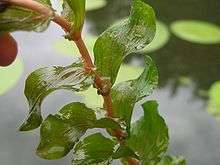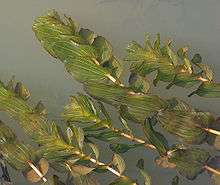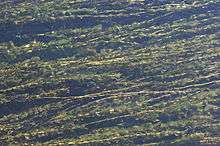Potamogeton perfoliatus
| Potamogeton perfoliatus | |
|---|---|
 | |
| Scientific classification | |
| Kingdom: | Plantae |
| (unranked): | Angiosperms |
| (unranked): | Monocots |
| Order: | Alismatales |
| Family: | Potamogetonaceae |
| Genus: | Potamogeton |
| Species: | P. perfoliatus |
| Binomial name | |
| Potamogeton perfoliatus L. | |
| Synonyms[1] | |
|
Buccaferrea amplexicaulis (Kar.) Bubani Peltopsis perfoliata (L.) Raf. Potamogeton alatofructus A.Benn. Potamogeton amplexicaulis Kar. Potamogeton bupleuroides Fernald Potamogeton loeselii Honck. Potamogeton praelongus F.Muell. Spirillus perfoliatus (L.) Nieuwl. | |
Potamogeton perfoliatus (claspingleaf pondweed,[2] perfoliate pondweed[3]) is a perennial aquatic plant in the family Potamogetonaceae occurring in both standing and flowing freshwater habitats. It is widely distributed globally, occurring in all continents except South America and Antarctica.
Description

Perfoliate pondweed grows from a robust creeping perennial rhizome, intermittently producing round stems up to 3 m long.[4] The submerged leaves are oval and translucent, with no stalk, 20–115 mm long and 7–42 mm wide, clasping the stem (perfoliate), a flat apex, and 5-12 veins on either side of the midrib.[4] They vary considerably in colour and may be bright green, dark green, yellowish, olive or brownish.[4] There are no floating leaves. The stipules are rather delicate and usually fall off quite soon after the new leaf has unfurled. The insignificant flowers are produced between June and September.[5] Fruits are 4 mm across, olive green in colour.
Two subspecies have been described. Subspecies perfoliatus occurs in the Old World. In North America, populations on the eastern seaboard and the Gulf States are considered to be subsp. bupleuroides.[6] Since many pondweeds, including P. perfoliatus, vary naturally in response to growing conditions,[4] it is possible that these variants are ecotypes rather than genuine subspecies. The related P. richardsonii was formerly considered a subspecies of P. perfoliatus, but is now classed as a separate species.[7]
Like most other broadleaved pondweeds, perfoliate pondweed is tetraploid, with 2n=52.[8]
Over much of its range, perfoliate pondweed is unlikely to be confused with any other pondweed species except perhaps P. praelongus. In North America it could be confused with P. richardsonii, but the latter has stipules that disintegrate to persistent fibres even on the lower part of the stem, whereas those of P. perfoliatus disintegrate entirely.[7]
However, perfoliate pondweed regularly hybridises with other Potamogeton species including P. crispus (P. × cooperi (Fryer) Fryer), P. gramineus (P. × nitens Weber), P.lucens (P. × salicifolius Wolfg.), P. alpinus (P. × prussicus Hagstr.), P. berchtoldii (P. × mysticus Morong), P. wrightii (P. × anguillanus Koidz.), P. maackianus (P. × leptocephalus Koidz.), P. alpinus (P. × prussicus Hagstr.), P. nodosus (P. × assidens Z. Kaplan, Zalewska-Gałosz et M. Ronikier), P. richardsonii (P. × absconditus Z. Kaplan, Fehrer & Hellq.), P. epihydrus (P. × versicolor Z. Kaplan, Hellq. and Fehrer) and P. praelongus (P. × cognatus Asch. & Graebn.).[1][4] The first three of these are quite common.[4] A triple hybrid, P. gramineus × lucens × perfoliatus (P. × torssandrii (Tiselius) Dörfler), is also known.[8] Many of these hybrids are perennial and long-lived, sometimes occurring in the absence of one or even both parents. Therefore, care should be taken with identification of unusual specimens.
Taxonomy
Potamogeton perfoliatus (perfoliate meaning that the leaf encircles the stem) was one of the original species named by Linnaeus in Species Plantarum (1753).
DNA analysis[9] indicates that P. perfoliatus is one of the broad-leaved pondweed clade (section Potamogeton) and is probably most closely related to P. richardsonii.
Distribution
Potamogeton perfoliatus has a broad global distribution, occurring in all continents except South America and Antarctica. It has been recorded from Asia (Afghanistan, India, Indonesia (Sumatra), Japan, Kazakhstan, Korea, Kyrgyzstan, Mongolia, Pakistan, Russia, Tajikistan, Uzbekistan), Australia,[10] North America (Eastern and SE USA),[11] Europe south to Spain, Central Italy and the Balkans and including Scandinavia, Britain, Ireland and Iceland,[6] North Africa (Algeria, Tunisia, Egypt),[6] the Near and Middle East. It is widespread in lakes and rivers in the British Isles and Ireland,[12] and is common in much of Eurasia and North America, but has a more scattered distribution towards the southern edge of its range.
Ecology and Conservation
P. perfoliatus grows in a wide range of freshwater habitats including lakes, rivers and streams, large ponds, canals and larger drains and ditches. It does not tolerate drying out, and the most robust plants tend to occur in >1 m water depth.[4] Unlike most other broad-leaved pondweeds it is reasonably tolerant of water flow and so can use running waters to a significant extent. It is not especially sensitive to water chemistry provided that the water remains reasonably clear and is not too base-poor, occurring in such diverse habitats as exposed Scottish lochs and lowland fenland rivers. However, at high nutrient concentrations it is vulnerable to shading from phytoplankton and epiphytic algae[13][14] and filamentous algae.[14] It may also grow in brackish or estuarine habitats, notably in Chesapeake Bay.[15][16] However, elevated salt concentrations have a negative effect on both growth and flowering.[17]

Waterbirds, fish,[15][18] water beetles and caddis larvae[19] can all be important grazers of perfoliate pondweed, reducing its biomass or even eliminating it locally.
Perfoliate pondweed is less threatened than other broadleaved pondweeds, but it is listed as Vulnerable in Spain[20] and the Netherlands[21] and Endangered in Flanders.[22] There are ongoing efforts to restore populations in Chesapeake Bay, where this was formerly a co-dominant species.[23][24][25]

Perfoliate pondweed is the commonest of the so-called Magnopotamion group of pondweeds. These are a characteristic floristic component of the protected Habitats Directive habitat Type 'Natural eutrophic lakes with Magnopotamion'.[26]
Cultivation
Perfoliate pondweed is not widely cultivated, which is perhaps surprising as it is not ecologically demanding and is an attractive plant. In common with other pondweeds of this group it roots poorly from stem cuttings and is best propagated by division of the rhizomes. It is easy to grow in a garden pond or even in a barrel, but unlike some other submerged plants needs to be able to root in a suitable substrate such as sand or aquatic compost. Keeping nutrient levels low helps to prevent smothering by algae and more invasive aquatic plants.[15] Plants being established should be weighted down initially to allow them to root, and benefit from being planted among other aquatic plants that can act as a 'nursery'.[24] Transplants have a high survival rate once established.[24]
P. perfoliatus may also be established from seed, which should be sown on a suitable substrate in shallow water. The seed should be left uncovered, or covered only with a minimal amount of substrate to hold the seed in place and allow root development, as seed buried more than 1 cm deep either does not germinate or the seedlings die.[25] The seed typically germinates within about 10 days.[25]
Although it is possible to grow perfoliate pondweed in fish ponds, it would be vulnerable to fish predation initially, so should be protected during establishment.
References
- 1 2 The Plant List: Potamogeton perfoliatus. Royal Botanic Gardens, Kew and Missouri Botanic Gardens. Accessed November 20, 2014
- ↑ "Potamogeton perfoliatus". Natural Resources Conservation Service PLANTS Database. USDA. Retrieved 13 October 2015.
- ↑ "BSBI List 2007". Botanical Society of Britain and Ireland. Archived from the original (xls) on 2015-02-25. Retrieved 2014-10-17.
- 1 2 3 4 5 6 7 Preston C.D. (1995) Pondweeds of Great Britain and Ireland. BSBI Handbook No. 8. Botanical Society of the British Isles, London.
- ↑ Rose, Francis (2006). The Wild Flower Key. Frederick Warne & Co. pp. 491–492. ISBN 978-0-7232-5175-0.
- 1 2 3 Naturhistorika riksmuseet (Sweden) Ålnate Potamogeton perfoliatus L., northern hemisphere range map
- 1 2 Haynes R.R., Hellquist C.B. Flora of North America: Potamogetonaceae. Accessed 11 November 2014.
- 1 2 Kaplan Z., Jarolímová V., Fehrer J, 2013. Revision of chromosome numbers of Potamogetonaceae: a new basis for taxonomic and evolutionary implications. Preslia, 85, 421-482.
- ↑ Lindqvist C., De Laet J., Haynes R.R., Aagesen L., Keener B.R., Albert V.A. 2006. Molecular phylogenetics of an aquatic plant lineage, Potamogetonaceae. Cladistics, 22, 568-588.
- ↑ Guo Y., Haynes R.R., Hellquist C.B., Kaplan Z. 2010. Potamogeton. Flora of China, 23, 108-114. http://www.efloras.org/florataxon.aspx?flora_id=2&taxon_id=200024699
- ↑ United States Department of Agriculture (USDA) Natural Resources Conservation Service: Plants Profile for Potamogeton perfoliatus. Accessed 25 October 2014.
- ↑ Preston C.D., Pearman D.A., Dines T.D. (2002) New Atlas of the British and Irish Flora: An Atlas of the Vascular Plants of Britain, Ireland, The Isle of Man and the Channel Islands. Oxford University Press, Oxford
- ↑ Twilley R.R., Kemp W.M., Staver K.W., Stevenson J.C., Boynton W.R. 1985. Nutrient enrichment of estuarine submersed vascular plant communities. 1. Algal growth and effects on production of plants and associated communities. Marine Ecology Progress Series, 23, 179-191.
- 1 2 Maëmets H., Freiberg L., Haldna M., Möls T. 2006. Inter-annual variability of Potamogeton perfoliatus stands. Aquatic Botany, 85, 177-183.
- 1 2 3 USDA Plant Factsheet: Claspingleaf pondweed Potamogeton perfoliatus.
- ↑ Caffrey J.M., Kemp W.M. 1992. Influence of the submerged plant, Potamogeton perfoliatus, on nitrogen cycling in estuarine sediments. Limnology and Oceanography, 37, 1483-1495
- ↑ van den Brink, F.W.B., van der Velde G. 1993. Growth and morphology of four freshwater macrophytes under the impact of the raised salinity level of the Lower Rhine. Aquatic Botany, 45, 285-297.
- ↑ Bråbrund A. 1985. Food of roach (Rutilus rutilus) and ide (Leusiscus idus): significance of diet shift for interspecific competition in omnivorous fishes. Oecologia, 66, 461-467.
- ↑ Jacobsen D., Sand-Jensen K. 1995. Variability of invertebrate herbivory on the submerged macrophyte Potamogeton perfoliatus. Freshwater Biology 34, 357-365.
- ↑ Moreno, J.C., coord. 2008. Lista Roja 2008 de la flora vascular española. Dirección General de Medio Natural y Política Forestal (Ministerio de Medio Ambiente, y Medio Rural y Marino, y Sociedad Española de Biología de la Conservación de Plantas), Madrid, 86 pp.
- ↑ Sparrius L.B., Odé B., Beringen R. 2014. Basisreport Rode Lijst Vaatplanten 2012 volgens Nederlandse en IUCN-criteria. FLORON Rapport 57. Floron, Nijmegen.
- ↑ Van Landuyt W., Vanhecke L., Hoste I. 2006. Rode Lijst van de vaatplanten van Vlaanderen en het Brussels Hoofdstedelijk Gewest. In : Van Landuyt W. et al. Atlas van de Flora van Vlaanderen en het Brussels Gewest. INBO en Nationale Plantentuin van België, Brussel. Web version.
- ↑ Shafer D., Bergstrom P. 2010. An Introduction to a Special Issue on Large-Scale Submerged Aquatic Vegetation Restoration Research in the Chesapeake Bay: 2003–2008. Restoration Ecology, 18, 481-489.
- 1 2 3 Hengst, A. 2007. Restoration Ecology of Potamogeton perfoliatus in mesohaline Chesapeake Bay: The nursery bed effect. M.Sc. Thesis, University of Maryland.
- 1 2 3 Ailstock M.S., Shafer D.J., Magoun A.D. 2010. Effects of Planting Depth, Sediment Grain Size, and Nutrients on Ruppia maritima and Potamogeton perfoliatus Seedling Emergence and Growth. Restoration Ecology, 18, 574-583.
- ↑ "Joint Nature Conservation Committee: 3150 Natural Eutrophic Lakes". Retrieved 2014-10-19.
External links
- Botanical Society of the British Isles Herbaria@Home
- West Highland Flora: Potamogeton perfoliatus
- Flora of North America: Potamogeton perfoliatus